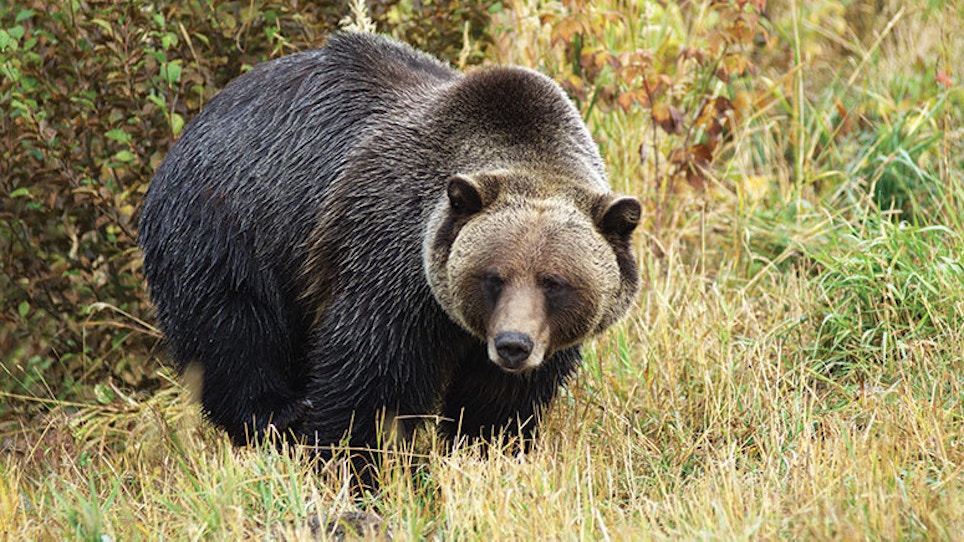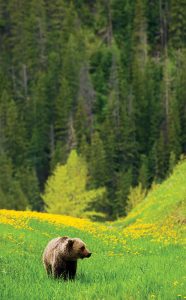Another conservation success story may result in new hunting opportunities in three western states. This time, grizzly bears are poised to come off the Endangered Species Act (ESA), paving the way for Montana, Wyoming and Idaho to take over management of the iconic Western animal. One management option is limited hunts.
The animals were listed as threatened in 1975 when populations dipped to as low as 200 throughout their historic range in the contiguous United States. Now, an estimated 1,700 roam the northern Rockies, with the highest concentrations around Yellowstone and Glacier national parks. That’s well above the recovery goal of a total of 500 bears, including 48 females with cubs and a sustainable population in two of six designated recovery zones.
Predictably, anti-hunting groups are protesting the mere mention of a managed hunt, claiming grizzly bears have not fully recovered. A letter sent to Department of the Interior Secretary, Sally Jewell, and U.S. Fish and Wildlife Service (USFWS) Director, Dan Ashe, claims grizzly bears are not fully recovered.
“Before 1800, approximately 50,000 grizzly bears roamed the Lower 48 states between Canada and Mexico. Today, wild grizzly bears number fewer than 1,700… Grizzly bears have not recovered across a significant portion of their range and thus, they are not recovered and should not be delisted,” says the letter, signed by dozens of scientists who may or may not have any knowledge of grizzly bears.
In other words, until 1,000-pound predators roam every square inch of their historic range, which includes the cities of Denver, Seattle and San Francisco, anti-hunters insist they deserve protection. It’s the same tactic they used when wolves were on the brink of de-listing, agrees Sportsmen’s Alliance president Evan Heusinkveld.
“Once wolves actually exceeded the recovery goals and the Fish and Wildlife Service recommended turning management back over to the states, anti-hunters insisted there still weren’t enough wolves or that they were not fully recovered because they didn’t occupy their historic range,” he says.
Science and common sense prevailed with wolves, which were ultimately removed from the ESA and turned over to individual states to manage their numbers. Montana and Idaho have held wolf hunts since they took over management. So far, wolf populations remain well above the original recovery goals and will likely stay there. What’s more, their range continues to expand, despite pre-hunt claims by anti-hunting groups that wolf populations would be decimated.
Of course, wolves weren’t turned over to states until the issue had worked itself through the legal system one last time. They reached their original recovery goals in 2002, just seven years after they were reintroduced into parts of Idaho and Yellowstone National Park. It wasn’t until 2008, however, that wolves were officially delisted and management was turned over to the states. A dozen animal rights groups immediately filed suit in an attempt to block hunts, effectively delaying state-run management efforts.
That’s likely what will happen with grizzly bears, says Huesinkveld. It’s already happened in Wyoming, where Humane Society of the United States (HSUS) and others insist the state has not given enough time for the public to comment on its grizzly bear management plan.
“Legal challenges are one way to prolong any possibility of managed hunts, even though the science that shows the animals are recovered is convincing,” he adds.
Of course, it depends on what science you want to believe. Anti-hunting groups fall back on various studies that suggest the bears are still in peril. One common concern is the decline of whitebark pines. In fact, grizzlies were originally delisted in 2007, but environmentalists countered that declining whitebark pine forests would ultimately spell doom for the bears. The trees produce a seed that is an important food source for grizzlies, which sometimes eat high quantities of pine seeds prior to denning for the winter. Whitebarks are facing serious challenges in the form of pine beetles — which have killed huge numbers throughout the West — a disease called rust, forest fires and warming temperatures. Hotter summers and shorter winters have allowed pine beetles to move into new territory and they have allowed the insects more time to do their damage. Those same changes in weather patterns, along with modern fire suppression policies, have also created more favorable fire conditions.
As it turns out, bears aren’t entirely dependent on the trees. A 10-year study from 2001 to 2010 by scientists with the U.S. Geological Survey (USGS) found that grizzlies are far more adaptive than once thought. A third of the bears in the study didn’t even utilize habitat with considerable whitebark pine presence. Those that did, found other food sources when pine nuts were scarce, which is a natural part of their growing cycle.
“The wide diet breadth and foraging plasticity of grizzly bears likely allowed them to adjust to declining whitebark pine. Bears reduced use of whitebark pine stands without increasing movement rates, suggesting they obtained alternative fall foods within their local surroundings,” the study’s authors wrote. It’s important to note that the USGS is neither in favor nor opposed to state-run management. That means it may or may not include hunting.
A study published in 2016 by members of the Interagency Grizzly Bear Study Team found that the decline of whitebark pine was not a factor in the decrease in the rate of the bears’ population growth. Anti-hunters again used the pine trees as ammunition in their fight against delisting. As the study found, the animals have simply outgrown their available habitat. Natural population control mechanisms, including cannibalism by adult males on cubs, is keeping bear populations in check.
“Cub survival and reproductive transition were negatively associated with an index of grizzly bear density, indicating greater declines where bear densities were higher,” wrote the study’s authors. “Our analyses did not support a similar relationship or the index of whitebark pine mortality. The results of our study support the interpretation that slowing of population growth during the last decade was associated more with increasing grizzly bear density than the decline in whitebark pine.”
Science be damned, though. HSUS president Wayne Pacelle calls the potential delisting “premature.” It’s the same for others opposed to taking the animals off the Endangered Species List (ESL). This includes former U.S. Fish and Wildlife Service director Jamie Rappaport Clark, who now serves as president of Defenders of Wildlife, which is a leading anti-hunting group.
“…states must realize that authorizing a hunting season for grizzlies immediately upon delisting is completely inappropriate. These animals have been protected under the ESA for decades and we can’t flip a switch and go from zero to 60 — from federally protected one day to sport hunting the next — without undermining the bear’s recovery,” wrote Clark in an opinion piece for Real Clear Politics.
For unknown reasons, Clark fails to acknowledge the long-term studies and monitoring efforts conducted by the very states that will be charged with managing
the bears. Wyoming Game and Fish (WG&F), for instance, has been monitoring grizzly populations since the 1970s, says WG&F Large Carnivore Biologist, Dan Thompson.
“They are one of the most studied animals on the planet. We have years of good research on them. To say we are rushing into delisting them is simply not true,” he says. “Our agency is being very careful with any discussion of hunting. We aren’t even proposing anything because technically, grizzlies are still listed and can’t be hunted.”
If Wyoming, Montana and Idaho do approve hunting seasons, they will likely be extremely conservative. Although specific numbers have not been released, the USFWS would grant 8 percent of the total hunting-related mortality to Idaho, 34 percent to Montana and 58 percent to Wyoming, which has the highest density.
Clark also doesn’t acknowledge that bears are already being killed by the dozens. Although illegal, ranchers have occasionally shot them to protect their livestock. In most instances, nuisance bears are killed by state and federal authorities. Last year, biologists euthanized 24 bears that were preying on livestock or becoming too comfortable around humans. Annual mortality rates by all methods, including poaching, vehicle collisions and protection of life or property is as high as 50 per year. Simply put, grizzlies are running out of habitat.
“They are very adaptable animals, but do we want them living in a feedlot or on the edge of a town? That wouldn’t end well for the bear and it wouldn’t be good for humans, either,” Thompson says. “Things aren’t the same as 200 years ago. The landscape has changed and bears won’t be accepted in most of what was once their historic range. Although the decision to delist bears is based on science, we have to consider the social carrying capacity.”







